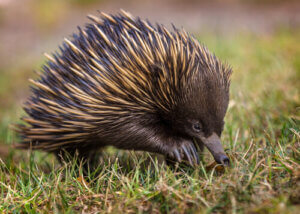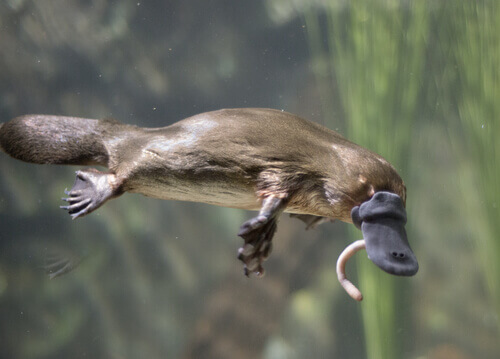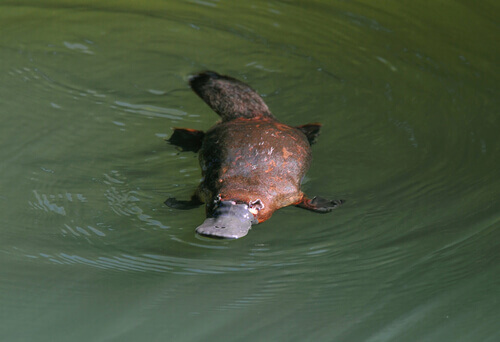Egg-Laying Mammals

We all know that the definition of mammals is “animals whose embryos develop inside the maternal womb”. However, monotremes are the exception to the rule. They’re egg-laying mammals!
Are there mammals that lay eggs?
It may seem a little strange to us, but in nature there are many curiosities. Pregnancies are one of the many things that draw our attention, because on many occasions they’re completely different from what we know.
Egg-laying mammals, or monotremes by their scientific name, share characteristics with the mammalia class, but also with reptiles. They reproduce oviparously, and have a “cloaca” (or orifice) where the urinary, digestive, and reproductive tracts meet.
According to research, they’re the most primitive types of mammals that exist today. That is, they’re the only ones that are between a reptile and a mammal.
What other traits do they have? The things they share with mammalia are the fur covering their skin, the production of milk to feed their young, the three bones of the middle ear, the diaphragm, the heart divided into four cavities, and a body temperature that ranges between 28 and 32°C (82 and 90°F).

They also have some peculiarities that don’t allow them to be 100% mammals. In addition to oviparity, their teeth are atrophied or absent. Also, they have no tear ducts and their snout ends in a beak. Their face is covered by leathery skin, and males have a spur on their hind legs.
Egg-laying mammals: echidna
This is a family of four species very similar to hedgehogs –like the one in the photo at the beginning of the article– that live in Oceania, specifically in Australia, Tasmania, New Guinea, and Salawati. They owe their name to the Ancient Greek mythological nymph that was covered with spines.
Echidnas have a compact body, about 45 cm (18 in) long and a tail of 10 cm (4 in). They can weigh 7 kg (15lb), and males are bigger than females. Their diet consists of earthworms and insects, so they have a proboscis and a long sticky tongue –similar to that of anteaters– of up to 20 cm (8 in) long.
The reproduction of echidnas is the most curious thing. After mating, females lay a single egg which incubates for 10 days. After that, the young sucks milk from the pores, as the mother has no nipples. It then remains in a pouch –like kangaroos– for almost two months while it develops the spines that it will use as protection.
For seven months the young will stay in a den, where the mother will go every five days to nurse it.
Egg-laying mammals: platypus
This semi-aquatic animal is one of the strangest out there, as it looks like a “mix” of several species: a duck’s beak, a beaver’s tail and otter’s legs. It’s also venomous, lays eggs, and only lives in eastern Australia.

It has a brown body and is covered with fur. Both its legs and the bill are black, and males can be twice as big as females.
For reproduction, the platypus pair performs a courtship display in the water, and after copulation the female goes to a burrow near the shore –about 20 m (66 ft) long– where it’ll develop the eggs in its uterus for about a month.
After that, it’ll lay them in a nest of wet leaves, and incubate them for 10 days. At birth, the hatchlings are very vulnerable, hairless and blind. Therefore, they’re completely dependent on their mother. She feeds them with milk, although it has no nipples and the young must lick its abdomen.
We all know that the definition of mammals is “animals whose embryos develop inside the maternal womb”. However, monotremes are the exception to the rule. They’re egg-laying mammals!
Are there mammals that lay eggs?
It may seem a little strange to us, but in nature there are many curiosities. Pregnancies are one of the many things that draw our attention, because on many occasions they’re completely different from what we know.
Egg-laying mammals, or monotremes by their scientific name, share characteristics with the mammalia class, but also with reptiles. They reproduce oviparously, and have a “cloaca” (or orifice) where the urinary, digestive, and reproductive tracts meet.
According to research, they’re the most primitive types of mammals that exist today. That is, they’re the only ones that are between a reptile and a mammal.
What other traits do they have? The things they share with mammalia are the fur covering their skin, the production of milk to feed their young, the three bones of the middle ear, the diaphragm, the heart divided into four cavities, and a body temperature that ranges between 28 and 32°C (82 and 90°F).

They also have some peculiarities that don’t allow them to be 100% mammals. In addition to oviparity, their teeth are atrophied or absent. Also, they have no tear ducts and their snout ends in a beak. Their face is covered by leathery skin, and males have a spur on their hind legs.
Egg-laying mammals: echidna
This is a family of four species very similar to hedgehogs –like the one in the photo at the beginning of the article– that live in Oceania, specifically in Australia, Tasmania, New Guinea, and Salawati. They owe their name to the Ancient Greek mythological nymph that was covered with spines.
Echidnas have a compact body, about 45 cm (18 in) long and a tail of 10 cm (4 in). They can weigh 7 kg (15lb), and males are bigger than females. Their diet consists of earthworms and insects, so they have a proboscis and a long sticky tongue –similar to that of anteaters– of up to 20 cm (8 in) long.
The reproduction of echidnas is the most curious thing. After mating, females lay a single egg which incubates for 10 days. After that, the young sucks milk from the pores, as the mother has no nipples. It then remains in a pouch –like kangaroos– for almost two months while it develops the spines that it will use as protection.
For seven months the young will stay in a den, where the mother will go every five days to nurse it.
Egg-laying mammals: platypus
This semi-aquatic animal is one of the strangest out there, as it looks like a “mix” of several species: a duck’s beak, a beaver’s tail and otter’s legs. It’s also venomous, lays eggs, and only lives in eastern Australia.

It has a brown body and is covered with fur. Both its legs and the bill are black, and males can be twice as big as females.
For reproduction, the platypus pair performs a courtship display in the water, and after copulation the female goes to a burrow near the shore –about 20 m (66 ft) long– where it’ll develop the eggs in its uterus for about a month.
After that, it’ll lay them in a nest of wet leaves, and incubate them for 10 days. At birth, the hatchlings are very vulnerable, hairless and blind. Therefore, they’re completely dependent on their mother. She feeds them with milk, although it has no nipples and the young must lick its abdomen.
This text is provided for informational purposes only and does not replace consultation with a professional. If in doubt, consult your specialist.








